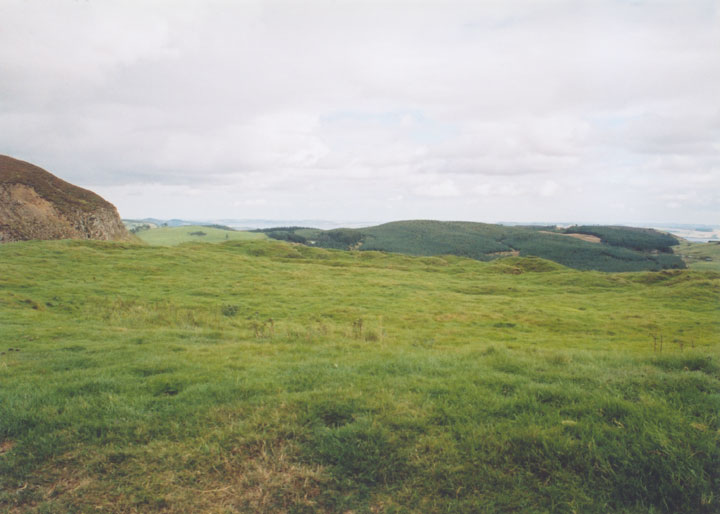







This tiny circle consists of 4 stones, only 2 of which still stand, the other two lying close to their original positions. None of the stones are more than 0.55m tall, and sit in very shallow sockets – one of the stones moves when touched. The circle is situated on a small mound close to the edge of a forestry plantation, and leading away from it are a perfectly-straight line of 5 hut circles, one of which crowns the summit of Elrig.
Visiting this circle it struck me how important the standing stones must have been to the people who erected them. From the looks of the landscape, this area would have been a temporary summer settlement, but the inhabitants still felt the need to build a stone circle – however small.
Directions – Park in the car park for the Cateran Trail at Enochdhu and follow the forest track to the north-east past Dirnanean and through Home Farm. Continue on up the hill past the sheep dips, and soon after you will come to a gate. About 250m after the gate you will pass the Calamanach stone. Keep on following the track as it turns to the left and continues uphill through the forest, where you will cross a stream. As you leave the forest at a deer fence, turn immediately to your left and follow the fence until you come to the circle, which sits in a kink in the fence.


















There’s what looks very like a standing stone here, complete with packing stones at the base. To begin with I thought (since it’s not listed anywhere) that it was maybe a marker for the track, but it’s on the wrong side of a ditch beside the track so would be useless for this purpose. I’ve e-mailed the county archaeologist to get his opnion.
details of a river walk (with directions) that goes past the cup-and-ring markings
Directions – park at Spittal of Glenshee, and walk past the church and across the A93 to a stile in the fence, sign-posted Cateran Trail. Head down over the wooden bridge, and follow the farm track up past Old Spittal farmhouse (windows boarded up). The track climbs up and round a bend just after the old farm, and you will see a large flat-topped hill rising up to your left. Climb up it’s steep sides, and at the top you will clearly be able to see the morain deposit with the stones sitting atop.
This is probably a site best visited in autumn, winter or spring. The stones are awfully wee, and were being dwarfed by the grass growing around them today. Access is via a farm track (no vehicles) and the stones are high up, so wet ground shouldn’t be a problem.
Although the mound on which the stones sit is was excavated in 1894 and reported to be a natural morain deposit, it does look very suspicious, and there are stones on the east side of it which could be the remnants of a kerb.
Finally found this site here today in glorious sunshine (and have the red face to show for it) after failing miserably in miserable weather 2 weeks ago. This is the remains of a four-poster, with 2 of the stones still standing, one half fallen over, and one lying on the ground.
The stones sit at the end of a much later building, and one of the stones has been incorporated into the farmstead.
This is definitely a site to visit in summer (or summer weather) rather than winter. The ridge on which the stones stand is littered with stones, and if you don’t know exactly what you’re looking for they can be difficult to spot. However, when the grass is dry it’s possible to see a very faint sheep track contrasting with the rest of the grass, and this will lead you direct to the stones (see directions below). There appears to be the remnants of a stone-marked track running past the stone setting – perhaps an original route through the glen, up away from the river and the wetter ground?
Directions – head north from Spittal of Glenshee, and after about 2.5km there is a small layby on the right of the road, almost opposite a double gate into the field on the left hand side of the road – park here. Go through the double gates, and head up the “track” that’s just visible in the grass. (You should be able to see a small wooden structure on the ridge)
When you get onto the flattish ridge, turn right and follow the faint sheep track through the ford in the burn, and follow it until a second ford maybe 200 or 300m further along. Once you come up out of this second burn, you should be able to see the 2 standing stones sticking up out of other assorted stones.

















